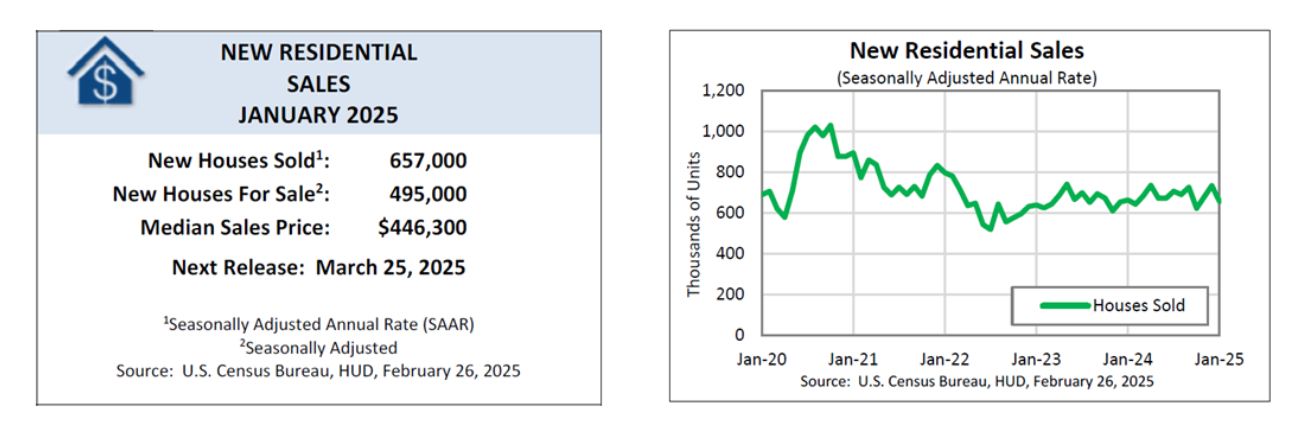Are you curious about the current state of the housing market and where it's headed? Well, let's dive into the world of new home sales. In a nutshell, new home sales in February 2025 reached a seasonally adjusted annual rate of 676,000, signaling a slight uptick from previous months, yet revealing underlying challenges in inventory management for homebuilders. Let’s explore the trends, dissect the data, and peek into what the rest of 2025 might hold.
New Home Sales, commonly referred to as “new residential sales,” is an economic indicator that tracks the sale of newly constructed residences. It is extensively watched by investors since it is seen as a lagging signal of real estate market demand and, thus, a factor influencing mortgage rates. Household income, unemployment, and interest rates are all variables that influence it.
The United States Census Bureau releases two versions of the New Home Sales metric: a seasonally adjusted figure and an unadjusted one. The adjusted value is shown as a yearly total, whereas the unadjusted figure is presented as a monthly total. These numbers are provided for several areas and the entire nation.
New home sales are completed when a sales contract or deposit is signed or accepted. In any stage of construction, the home might be: not yet started, in the process of being built or fully finished. About 10% of the US housing market is made up of new house sales. Preliminary numbers for new single-family home sales are subject to major changes because they are mostly based on data from construction permits.
New home sales in January 2025 dipped, dropping to a seasonally adjusted annual rate of 657,000. While this figure represents a slight decrease from both the previous month and the year prior, several factors are at play, painting a complex picture of the housing market in 2025. Let's dive into the details and explore what this means for buyers, builders, and the economy as a whole.
New Home Sales: Trends and Forecast for 2025

According to recent data, new home sales in February 2025 were up 1.8% from January and 5.1% from February 2024. Sounds positive, right? While these numbers show an increase, they don't tell the whole story.
- Sales: February 2025 saw a seasonally adjusted annual rate of 676,000 new homes sold.
- Median Sales Price: The median price was $414,500.
- Average Sales Price: The average price hit $487,100.
- Inventory: There were 500,000 new houses for sale, representing an 8.9-month supply at the current sales rate.
Now, here's the twist. An 8.9-month supply of homes means there's a considerable inventory sitting around. This is where things get interesting and a bit tricky for builders.
The Inventory Conundrum: A Builder's Headache
You see, a high inventory of unsold new homes can put pressure on builders. Think about it: the more houses sitting empty, the more costs the builders have to bear – maintenance, insurance, and the opportunity cost of not being able to invest that capital elsewhere. This leads to builders becoming more cautious about starting new projects, which in turn affects housing permits.
- Completed Units for Sale: A key indicator to watch is the number of completed units for sale. Historically, when this number nears 120,000, builders start to pump the brakes on new permits. In February 2025, we were awfully close to that level, sitting at 119,000.
As someone who's followed the housing market for years, I've seen this pattern play out time and again. Builders are savvy. They don't want to be stuck with a glut of unsold homes. That's why they carefully watch these inventory levels.
New Home Sales Forecast for the Remainder of 2025: What to Expect
Two major factors always loom large in the housing market: mortgage rates and potential tariffs.
- Mortgage Rates: When rates are low, more people can afford to buy homes. This increased demand helps builders sell their inventory. Conversely, high rates can scare away buyers. A potential sweet spot for builders seems to be around the 6% mark. Historically, when mortgage rates stabilize around this level, builder confidence tends to improve.
- Tariffs: The possibility of new tariffs adds another layer of uncertainty. Tariffs can increase the cost of building materials, squeezing builders' profit margins. This naturally makes them more hesitant to start new projects.
What's the Forecast for the Rest of 2025?
Predicting the future is never easy, but based on the current trends, here's my take on what we can expect for the rest of 2025:
- Stable Sales, Moderate Growth: I anticipate new home sales will remain relatively stable, with maybe some moderate growth if mortgage rates cooperate. Don't expect any boom or bust.
- Inventory Management is Key: Builders will remain hyper-focused on managing their inventory. We might see some strategic price adjustments or incentives to move existing homes.
- Housing Permits: Unless we see a significant drop in mortgage rates or some positive news on the tariff front, I don't foresee a major surge in housing permits.
Looking Ahead: My Opinion
Based on my knowledge, expertise, and years of closely watching the housing market, here are some key points to consider:
- The market is in a state of flux: We aren't experiencing the highs of a few years ago, nor the lows of a major crash.
- Builders are adapting: They are becoming more sophisticated in their approach to inventory management and risk assessment.
- External factors play a huge role: Mortgage rates, tariffs, and the overall economic climate will continue to heavily influence the housing market.
Navigating the Housing Market in 2025
So, what does all this mean for you, whether you're a potential homebuyer, a builder, or just curious about the market?
- For Homebuyers: If you're looking to buy, keep a close eye on mortgage rates. A slight dip could open up opportunities. Also, don't be afraid to negotiate – with the current inventory levels, builders might be willing to offer incentives.
- For Builders: Focus on managing your existing inventory and be cautious about starting new projects until the market becomes more stable.
- For Everyone: Stay informed! The housing market is constantly evolving. Keep track of the latest data, trends, and expert opinions to make informed decisions.
In conclusion, while new home sales in early 2025 show a slight increase, the larger picture is one of careful navigation. Builders are focused on managing inventory, and external factors like mortgage rates and tariffs will continue to play a significant role in shaping the market. Stay tuned for more updates as the year progresses.
New Home Sales Trends [Previous Months]
Here's the region-wise tabular data for new home sales from January 2024 to January 2024. The units displayed are in thousands and are the seasonally adjusted annual rate. The data estimates only include new single-family residential structures. Sales of multi-family units are excluded from these statistics.
NORTHEAST: Connecticut, Maine, Massachusetts New Hampshire New Jersey New York Pennsylvania Rhode Island Vermont
MIDWEST: Illinois, Iowa, Indiana, Kansas, Michigan, Minnesota, Missouri, Nebraska North Dakota Wisconsin South Dakota Ohio
SOUTH: West Virginia, Virginia, Texas, Tennessee, South Carolina, Oklahoma, North Carolina, Mississippi, Maryland, Louisiana, Kentucky, Georgia, Florida, Alabama, Delaware, District of Columbia, Arkansas
WEST: Alaska, Arizona, California, Colorado, Hawaii, Idaho, Montana, Nevada, New Mexico, Oregon, Utah, Washington, Wyoming



